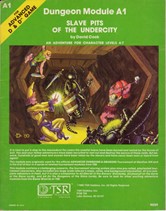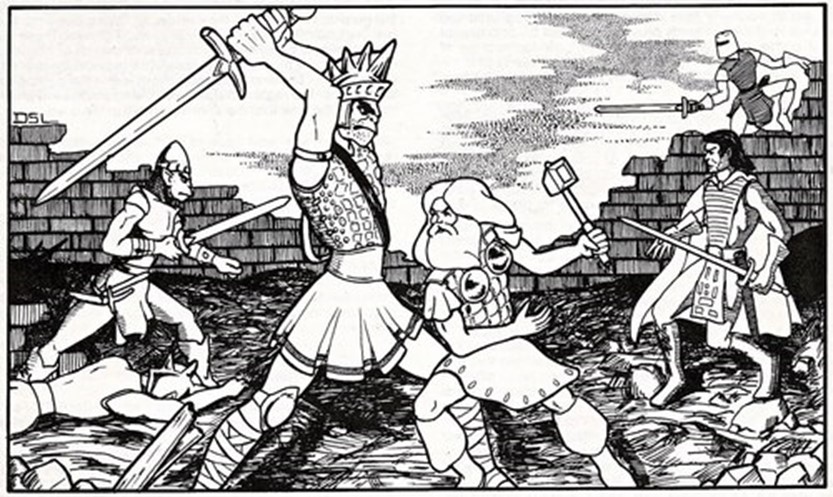 Slave Pits of the Undercity is the first adventure in the Aerie of the Slave Lords series. This series of adventures was originally designed for the official AD&D Tournament at GenCon XIII in 1980. It was a very unusual undertaking: the first round was actually five separate adventures, each undertaken by different groups. The semi-final was a sixth adventure, and the final round was a seventh adventure. The whole was published in the four “A” (Aerie of the Slave Lords) modules, with the first six adventures being each taking up half a module, and with the finale being published in A4.
Slave Pits of the Undercity is the first adventure in the Aerie of the Slave Lords series. This series of adventures was originally designed for the official AD&D Tournament at GenCon XIII in 1980. It was a very unusual undertaking: the first round was actually five separate adventures, each undertaken by different groups. The semi-final was a sixth adventure, and the final round was a seventh adventure. The whole was published in the four “A” (Aerie of the Slave Lords) modules, with the first six adventures being each taking up half a module, and with the finale being published in A4.
The concept behind the adventures was that the coastal towns of the world of Greyhawk were being burned and looted by the forces of the Slave Lords. In retaliation, the lords of these lands have hired several bands of adventurers to infiltrate the base and destroy the threat. Thus, each of the first five adventures finds a group of adventurers infiltrating a slaver base and trying to discover their headquarters – the Aerie of the Slave Lords.
Now, if you attempt to run the adventures as they were originally designed, this obviously will give you a few problems; you could actually play the entire story purely with A3 and A4! Later on, TSR drastically remodelled the series in their A1-4 Scourge of the Slavelords super-adventure. (I promise I’ll review that adventure in due course). The actual published version of the adventures links each adventure together so you can play through A1, A2, A3 and A4 in that order, but it is worth noting that this isn’t the original way they were played.
The published adventures provide more information than the original tournament scenarios, providing extra areas to explore and a few links between the tournament adventures. One of these extra links is room 19 in the sewer area of A1, which provides a map leading to the Slaver Stockade of A2.

So, what are the adventures like? Sadly, the answer derives from their tournament origin: they’re very linear. Indeed, they’re the most linear modules we’d seen so far from TSR; we’d see more of this in the future. Here’s a brief description of the two adventures in this module.
Ruined Temple of the Slave Lords
In the city of Highport, which has been overrun by goblins and other humanoids, stands a ruined temple. The party has come to it due to rumours of slaver activity. A secret passage leads inside the walls and to the treacherous ruined area, which has collapsing floors, undead and strange plants.
Eventually, the slavers can be found – with a few deceptive encounters – and the leader of this outpost, a 6th level evil cleric, can be faced. The most interesting encounter in this section is a group of “slaves” that are actually half-orcs pretending to be slaves (and thus will ambush the PCs if they’re unwary).
Slave Pits of the Undercity
The other adventure presumes the group has infiltrated Highport and learnt that the slavers take their slaves to the sewers… where they disappear. Following on that lead takes them through chambers of Aspis (an new ant-man monster), to an orc and ogre guardpost, a few traps, and finally to the slave pits themselves, where the slaves are held in cages, and the slave lord’s den where they face a 7th level thief. The most memorable encounter is the fight on the slave pits, where you’re balancing on beams above the open cages.
Ahem.
There are two new monsters in this adventure – the Aspis and the Giant Sundew (which sees action in the first part) – neither of which inspires all that much; certainly they didn’t see much use in subsequent adventures.
What really works in Slave Pits of the Undercity is the concept. There are a few good encounters, but the overall result isn’t that favourable. The attempts to expand upon the tournament adventures don’t add that much of interest. In the sewer levels, we get more chambers with ants and aspis, as well as a bit more of the slave pits. On the ground level, we get a couple of garden areas, some ruined areas, and the stables and gatehouse. It makes it works slightly better as an adventure setting (although the map doesn’t make all that much sense), but some of the extra encounters just look to be randomly deadly and don’t fit the adventure that much. (Two basilisks in the ruined section? Really?)
If you examine the David LaForce artwork above, you’re probably looking at a bearded female dwarf. At least, I hope you are. The artwork in this adventure is some of the weakest of TSR during this period; there’s not really that much to recommend it.
As you can probably tell, I’m not very fond of Slave Pits of the Undercity. I’ve both played it and run it, and though it served its purpose of a diversion for a few hours, the material here is very slight. There are a few challenging encounters, a couple that will make you think, a dearth of role-playing opportunities, and a lot of boring, mundane material. The series would get better before the end, but it didn’t begin well.
At time of writing, the adventure is not available in PDF form, but can be found in a reprint edition.

One thought on “AD&D Review – A1: Slave Pits of the Undercity”